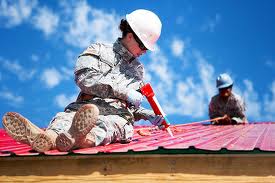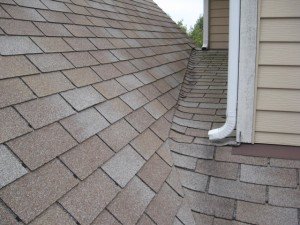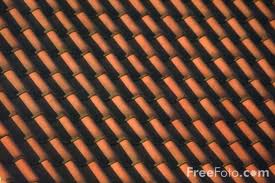Archive for the ‘Roof Materials’ Category
Choosing The Right Roof Material
 As homeowners, we take pride in the look of our homes. We cut the grass, trim the hedges, sweep the driveway and touch up the paint around the outside of the home. So why are many of us not taking the time to pick the right roof material for our home?
As homeowners, we take pride in the look of our homes. We cut the grass, trim the hedges, sweep the driveway and touch up the paint around the outside of the home. So why are many of us not taking the time to pick the right roof material for our home?
The roof is one of the largest structures of our home and it should be kept in good condition, just like any other part of the home.
When it comes to roof repair or replacement, many people spend less than 15 minutes choosing which roof material is best for their home.
There are many different types of roof materials, each with their own advantages and disadvantages. When considering which roof material would look best for your new roof, consider the following:
The style of your home
The style of your home says a lot about its features, the time period in which it was built and the overall appeal of the home. If you live in a Spanish style home, an earth tone, clay tile would be a great option to match the home’s style. A Victorian or Colonial style home would look great with a dark colored slate tile or metal roof. The idea is to match the home’s color palate while also adhering to the design features of the home.
The statement you want to make
With so many new roof materials available, many people are tempted to upgrade their roof using more modern materials. In general, using upgraded materials is a good choice and can even increase the value of your home. However, consider the re-sale value of the roof material you choose. Don’t over personalize your roof, making it hard for potential buyers to see your vision or agree with your design taste down the road. If you aren’t sure about your choice, ask your neighbor’s opinion.
The quality you are looking for
Many roof materials now come in various levels of quality. Composite asphalt shingles come in many varieties, each with different levels of durability and warranties. A higher quality roof material may cost you a little more, but can save you money down the road by requiring less repairs and even save you money by making your home more energy efficient. Solar panels and recycled roof materials are high quality roof products that can improve the energy efficiency of your home, while helping the environment.
Metal Roofs Save Money In Long Run
Metal roofs, are not the tin roofs of yesteryears, they have changed dramatically from the old barn roofs and sheds. Metal roofs are an attractive, durable, energy efficient and practical option for many homes.
Although initially metal roofs can cost twice as much as an asphalt roof, you will save money in the long run. Metal roofs reflect the heat away from your roof keeping your attic cooler and reducing the cost of energy use in the warmer months. Metal roofs can also last hundreds of years and usually come with 50 year warranties, far outlasting the traditional asphalt roof. Metal roofs also stand up to hail, wind and fire better than most roofing materials saving you money on repairs.
More Versatility
Today’s metal roofs are made in a variety of colors and styles. Metal roofs made of either aluminum or steel are made to resemble shingles or shakes. The aluminum panels come in various sizes depending upon the manufacturer. The principle manufactures now making these panels are the major aluminum companies. Another type of metal roofing panel is called ‘decramastic’ roof tile made of relatively lightweight galvanized steel, and covered with mastic and mineral granules.
Metal roofs are interlocked and screwed down making them less susceptible to the wind damage, but it does take longer to install than asphalt roofs accounting for some of the additional installation costs. Check with your contractor or roofer to determine if your metal roof qualifies for an Energy Star tax credit.
Roof Tiles
Clay roofing tiles date back 5,000 years ago to China. Tile roofs are fireproof as well as long lasting and beautiful. Clay tile roofs have long been the standard of attractive, durable and heavy roofs, especially currently in the southwest.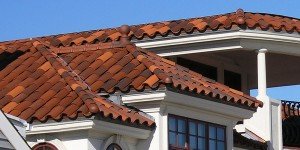 Gaining popularity are concrete tiles developed and mass produced in Europe in the early 1900’s. The tiles are fireproof, immune to rotting, termite and rodent damage. Concrete tiles resist weathering of all types and grow stronger with age. Concrete tiles can be installed up to 40% faster than traditional clay tiles.
Gaining popularity are concrete tiles developed and mass produced in Europe in the early 1900’s. The tiles are fireproof, immune to rotting, termite and rodent damage. Concrete tiles resist weathering of all types and grow stronger with age. Concrete tiles can be installed up to 40% faster than traditional clay tiles.
Concrete tiles are a couple hundred pounds lighter per square foot than clay tiles. Clay tiles also become heavier when they are wet. Concrete tiles cost less than clay, shakes and some metal roofing materials. Concrete tiles come in many shapes and colors. The concrete tiles are molded with a ridge on the back that hooks over sheathings making installation easier than traditional clay tiles.
A new roof built to code can easily handle the weight of tiles. Clay tiles are usually over 1,000 pounds per square, while concrete tiles are in the range of 750-900 pounds per square. If you are putting a new tile roof on your home, you may need to add some additional framing or joists for the extra weight. Your roofer, contractor or tile distributor can help you evaluate your needs.
Sealed Roofs Hold Up Better in Hurricanes
Research shows roof-deck seams that are sealed can protect from rain and high wind damage. The engineers at Insurance Institute for Business and Home Safety conducted experiments about water penetration from gusty winds and rain such as with hurricanes.
For residential roofs the rain from storms can breach the openings in the roof deck seams causing thousands of dollars in damage. To reduce the damage cover the seams on the outside of your roof with a modified bitumen tape and from the inside with closed cell foam spray adhesive.
At their research center in South Carolina, IBHS built a 1,300 square foot single story duplex to perform extensive tests. They wanted to determine the extent of water damage that occurs during hurricanes and other wind driven rain. They placed the building into a 21,000 square foot test chamber and subjected it to high speed, multi directional winds and simulated rain at 8” per hour.
With the exception of using the modified bitumen tape to seal between the sheathing joints and gaps on one side of the roof, both sides of the duplex were identical, complete with furniture, light fixtures and ceiling fans. The tests clearly showed that water damage was substantially less in the roof that has had the deck seams sealed. The unsealed side had water streaming off the light fixtures and ceiling fans and the ceiling collapsed from the attic being saturated with water. On the sealed side much less water entered the duplex.
According to an adjuster, the damage from the unsealed side was three times the amount of damage to the sealed side. Sealing your roof can greatly reduce the chances of a wide-spread loss due to water damage. Sealing an average sized roof with modified bitumen tape costs approximately $500. You might want to ask a roofer or contractor is this is a good option for you.
Metal Roofs Targeted By Criminals
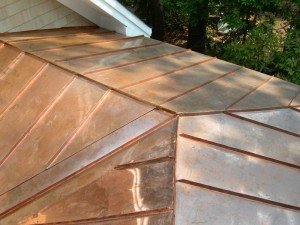 We have all heard of criminals stealing metal pipe and wires from builds to sell for a few dollars, but metal theft is now moving into new territory. As the economy challenges us to make ends meet, a new style of crime is evolving. Metal roofs have become increasingly popular among metal thieves, robbing many unsuspecting home and business owners of their roof materials.
We have all heard of criminals stealing metal pipe and wires from builds to sell for a few dollars, but metal theft is now moving into new territory. As the economy challenges us to make ends meet, a new style of crime is evolving. Metal roofs have become increasingly popular among metal thieves, robbing many unsuspecting home and business owners of their roof materials.
In The News
Earlier this week, a church in England reported a significant portion of their metal roof was stolen for the third time. A Canadian business had its galvanized metal roof drip edges stolen by thieves, costing the business owner thousands of dollars in repairs and installation of an upgraded security system.
Thieves around the world are cashing in on the high demand for quality metal products. Since metal roofs are usually made from aluminum, steel or copper; thieves may be able to make significantly more when selling the stolen pieces to scrap yards.
Reliably Resourceful
Home and businesses owners favor metal roofs for two reasons (1) its durability and product life and (2) its aesthetic appeal. The cost of roof repair tends to be less with metal roofs as they, generally, rarely need repairing. Metal roofs offer a lighter weight alternative to traditional asphalt roof shingles and require less maintenance. They also fit nicely into the green roofing lifestyle, as much of metal roof products are made from recycled materials.
Replacing and Repairing Composition Shingles
It is good practice to check your roof yearly for cracked, curled, broken or missing composition shingles, also called asphalt shingles. Most roofing materials eventually wear out and need to be replaced. If you are comfortable walking around on your roof, you can usually make simple repairs yourself.
When repairing and replacing broken shingles, it is best to choose a warm day so the shingles are more pliable. You want them to lift and bend easily. If it is cold outside, you can use a propane torch to heat them up.
Install new shingles from the bottom up and place the top row under the ridge cap. Nail each 3 tab shingle with 4-8 nails on the printed line on the shingle. Leave a slight gap between shingles. If it is too hard to get underneath the shingle to put the nails, use 1 ¼” exterior screws.
Pull out any shingles in poor condition, remove nails and slip in replacement shingles. You don’t need to be perfect when replacing shingles, but try to match the shingle thickness to achieve a relatively even surface.
- Fill cracks with roofing cement.
- Put roofing cement under curled edges.
- For broken shingles, pry out the nails and pull out damaged shingles, cut notches in the new shingle to match the nail tears in old one. Slide new shingle in place and nail it down.
Tools needed:
- Sturdy ladder
- Hammer or hatchet
- Sharp utility knife
- Pointed trowel for applying cement
- Roofing nails 1” to 1 ½ “
- Composition shingles
- Roofing cement
If you are replacing shingles in valleys or around flashings, using the damaged piece as a pattern trim the shingles accordingly and use roofing cement to help hold them in place. Be sure not to obstruct the path of the valley so water does not build up.
Self Repairing Solar Cells
MIT researchers have developed microscopic solar cells that mimic the way plant cells create energy from sunlight. The cells make use of proteins turning sunlight into electric charges. These solar cells just billionths of a meter across are longer lasting and more efficient than static photovoltaic cells.
Made up of a synthetic molecular mixture containing phospholipids that, when mixed with a solution, create a structural support that responds to light and can realign the system once electrons are “knocked loose” by the particles of light. The synthetic cells are able to self assemble and self repair themselves, just like plant cells do, when they are damaged by the destructive mixture of sunlight and oxygen.
The MIT researchers tested a prototype of the synthetic molecules, discovering the system to be 40% efficient–about double of the most advanced solar cells currently available. Photovoltaic cells are prone to reduced efficiency due to dust, debris, hail, and most often the sun itself, extended exposure to the sun gradually damages their internals, reducing their useful lifetime. In just 60 hours, efficiency can sometimes plummet as much as 90%.
This new research opens the possibilities for inexpensive, self repairing solar cells with an extended and possibly indefinite lifetime.
New Polymer Roofing Panels
A new roofing panel promise to reduce energy costs and increase a homes value. Echo Tech, a Los Angeles based company, claims their interlocking polymer panels are the most sustainable to date. The new interlocking polymer roofing panels are suppose to be unbreakable, heat-reflective, resistant to mold, mildew and algae. Are class A fire resistant and resist winds up to 130 mph. Making the roofing panels long lasting and cost effective.
The highly-advanced polymer material also, similar to how white roofs do, reflect heat off of homes, which reduces energy costs during the warmer months. Echo Tech says. each panel is made from polymers that create zero production waste. Making them a good option for environmentally minded consumers.
Offering both style and sustainability, NuSlate panels are designed to look like a variety of other roofing materials, such as cedar, wood or slate, although stronger and more durable. Echo Tech says this may be the last roofing material a homeowner would need to buy since the panels are so resilient.
Composition Shingles
Many homeowners are likely to install composition shingles, also called asphalt shingles, themselves. These shingles come in a wide range of styles and colors and some are guaranteed up to thirty years. Up to 80% of the homeowners in this country have composition shingles because of the economy and options available. Asphalt shingles have excellent fire protection and are easy to repair; the downside is they are vulnerable to wind and ice damage.
There are two types of shingles available, organic (generally felt saturated with asphalt) and non-organic, (which is fiberglass). Commonly referred to as “3-tab” shingles, is still the favorite among the several kinds of asphalt roofing. The 1×3 foot strip has two short ½ inch cut outs at one foot intervals to give it three shingle tabs. The 3-tab is still widely used today, but also the no-tab, the irregular-butt shingles plus several types of double layer laminated shingles, all still keeping the same approximate 1×3 dimensions.
In recent years new manufactures methods, plus the double layering and use of larger heavier granules, have pushed shingle weights to 300 pounds or more per 100 square feet, giving them better ’blow off’ resistance. Prices range from the very inexpensive plain flat shingles to the more costly shingles with better quality, added features and longer durability. Since shingles are susceptible to algae growth, an anti algae coating will be more expensive but worth it.
Some shingles now are available with recycled content and many states have asphalt shingle recycling centers where they are turning old shingles into paving materials for our roads.
When installing the shingles, you will need roofing felt, metal drip edges, flashings for valleys and vents and 2 pounds of roofing nails per square (100 square feet). Nails should be long enough to penetrate the roof decking.
Combine Both an Eco-Roof with a Solar Panel Roof
Chemistry and biology professors, Carl Wamser and Todd Rosenstial from Portland State’s Science Campus have been testing the combination of both solar panels and eco-roofing to see if they can double the impact. On top of the roof of the campus are herbs such as thyme and sage as well as solar panels.
What better way to combine these two eco-friendly roofing movements than on top of the enormous building. Green roofs (roofs with plants, grass and flowers on them) affect the water runoff from storms. Instead of directing it back into the rivers and streams, it is held and evaporates when the temperature rises. This helps cool down the urban environment and puts oxygen back into the atmosphere. It can also be a place of habitat for birds and small animals.
Solar panels being used on rooftops generate power from sunlight. By having both of these energy saving systems on the roof you are effectively doubling your eco-friendliness.
The professors were given a $300,000 grant to start the testing of the solar panel and green roof combination. As solar panels generate more power in cooler temperatures, the roof temperature is kept cooler due to the water retained by the roof garden. The cooler environment has increased the efficiency of the solar panels and the return on investment will be higher.
The data that is being found or projected to be found over the next 36 months could directly affect the eco-friendly roof choices for those homes, businesses and community buildings who have either solar panels or green roofs (and vice versa). The professors will continue to monitor results, checking just how much impact the green roof has on maintaining or reducing the roof temperature, how it affects the urban temperature and how they can continue to run the solar panels at maximum efficiency.
Are individual solar panel roofs and green roofs a thing of the past? Should they be combined to have a greater effect? At the moment, it looks that way.
Source: http://www.dailyvanguard.com



